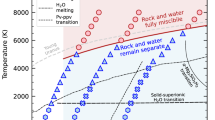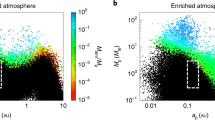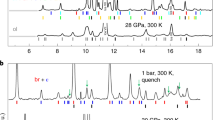Abstract
Water is an important component of exoplanets, with its distribution, that is, whether at the surface or deep inside, fundamentally influencing the planetary properties. The distribution of water in most exoplanets is determined by yet-unknown partition coefficients at extreme conditions. Here we first conduct ab initio molecular dynamics simulations to investigate the metal–silicate partition coefficients of water up to 1,000 GPa and then model planet interiors by considering the effects of water content on density, melting temperature and water partitioning. Our calculations reveal that water strongly partitions into iron over silicate at high pressures and, thus, would preferentially stay in a planet’s core. The results of our planet interior model challenge the notion of water worlds as imagined before: the majority of the bulk water budget (even more than 95%) can be stored deep within the core and the mantle, and not at the surface. For planets more massive than ~6 M⨁ and Earth-size planets (of lower mass and small water budgets), the majority of water resides deep in the cores of planets. Whether water is assumed to be at the surface or at depth can affect the radius up to 15–25% for a given mass. The exoplanets previously believed to be water-poor on the basis of mass–radius data may actually be rich in water.
This is a preview of subscription content, access via your institution
Access options
Access Nature and 54 other Nature Portfolio journals
Get Nature+, our best-value online-access subscription
$32.99 / 30 days
cancel any time
Subscribe to this journal
Receive 12 digital issues and online access to articles
$119.00 per year
only $9.92 per issue
Buy this article
- Purchase on SpringerLink
- Instant access to full article PDF
Prices may be subject to local taxes which are calculated during checkout





Similar content being viewed by others
Data availability
Authors can confirm that all relevant data are included in the Article and Supplementary Information files. Data used in the figures and our raw simulation outputs are available from figshare at https://doi.org/10.6084/m9.figshare.25800577 (ref. 74).
Code availability
The VASP is a proprietary software available for purchase at https://www.vasp.at/. The code for performing planetary interior modelling is available from the corresponding authors on reasonable request.
References
Fegley, B., Lodders, K. & Jacobson, N. S. Volatile element chemistry during accretion of the earth. Geochem. 80, 125594 (2020).
Boley, K. M. et al. Fizzy super-Earths: impacts of magma composition on the bulk density and structure of lava worlds. Astrophys. J. 954, 202 (2023).
Raymond, S. N. & Morbidelli, A. in Demographics of Exoplanetary Systems: Lecture Notes of the 3rd Advanced School on Exoplanetary Science (eds Biazzo, K. et al.) 3–82 (Springer, 2022).
Kite, E. S. & Barnett, M. N. Exoplanet secondary atmosphere loss and revival. Proc. Natl Acad. Sci. USA 117, 18264–18271 (2020).
Vazan, A., Sari, R. & Kessel, R. A new perspective on the interiors of ice-rich planets: ice–rock mixture instead of ice on top of rock. Astrophys. J. 926, 150 (2022).
Schlichting, H. E. & Young, E. D. Chemical equilibrium between cores, mantles, and atmospheres of super-Earths and sub-Neptunes and implications for their compositions, interiors, and evolution. Planet. Sci. J. 3, 127 (2022).
Lichtenberg, T. et al. Vertically resolved magma ocean-protoatmosphere evolution: H2, H2O, CO2, CH4, CO, O2, and N2 as primary absorbers. J. Geophys. Res. Planets 126, e2020JE006711 (2021).
Dorn, C. & Lichtenberg, T. Hidden water in magma ocean exoplanets. Astrophys. J. Lett. 922, L4 (2021).
Li, Y. G., Vocadlo, L., Sun, T. & Brodholt, J. P. The Earth’s core as a reservoir of water. Nat. Geosci. 13, 453–458 (2020).
Yuan, L. & Steinle-Neumann, G. Strong sequestration of hydrogen into the Earth’s core during planetary differentiation. Geophys. Res. Lett. 47, e2020GL088303 (2020).
Tagawa, S. et al. Experimental evidence for hydrogen incorporation into Earth’s core. Nat. Commun. 12, 2588 (2021).
Yuan, L. & Steinle-Neumann, G. Possible control of Earth’s boron budget by metallic iron. Geophys. Res. Lett. 49, e2021GL096923 (2022).
Li, Y. G., Vocadlo, L., Ballentine, C. & Brodholt, J. P. Primitive noble gases sampled from ocean island basalts cannot be from the Earth’s core. Nat. Commun. 13, 3770 (2022).
Deng, J. & Du, Z. Primordial helium extracted from the Earth’s core through magnesium oxide exsolution. Nat. Geosci. 16, 541–545 (2023).
Stixrude, L. Melting in super-Earths. Phil. Trans. R. Soc. A 372, 20130076 (2014).
Fei, Y. W. et al. Melting and density of MgSiO3 determined by shock compression of bridgmanite to 1254GPa. Nat. Commun. 12, 876 (2021).
Kraus, R. G. et al. Measuring the melting curve of iron at super-Earth core conditions. Science 375, 202–205 (2022).
Unterborn, C. T. et al. The nominal ranges of rocky planet masses, radii, surface gravities, and bulk densities. Astrophys. J. 944, 42 (2023).
Luger, R. & Barnes, R. Extreme water loss and abiotic O2 buildup on planets throughout the habitable zones of M dwarfs. Astrobiology 15, 119–143 (2015).
Crida, A., Ligi, R., Dorn, C. & Lebreton, Y. Mass, radius, and composition of the transiting planet 55 Cnc e: using interferometry and correlations. Astrophys. J. 860, 122 (2018).
Ridden-Harper, A. R. et al. Search for an exosphere in sodium and calcium in the transmission spectrum of exoplanet 55 Cancri e. Astron. Astrophys. 593, A129 (2016).
Hammond, M. & Pierrehumbert, R. T. Linking the climate and thermal phase curve of 55 Cancri e. Astrophys. J. 849, 152 (2017).
Dorn, C., Mosegaard, K., Grimm, S. L. & Alibert, Y. Interior characterization in multiplanetary systems: TRAPPIST-1. Astrophys. J. 865, 20 (2018).
Bourrier, V. et al. The 55 Cancri system reassessed. Astron. Astrophys. 619, A1 (2018).
Bean, J. L., Raymond, S. N. & Owen, J. E. The nature and origins of sub-Neptune size planets. J. Geophys. Res. Planets 126, e2020JE006639 (2021).
Mousis, O. et al. Irradiated ocean planets bridge super-Earth and sub-Neptune populations. Astrophys. J. Lett. 896, L22 (2020).
Emsenhuber, A. et al. Realistic on-the-fly outcomes of planetary collisions. II. Bringing machine learning to N-body simulations. Astrophys. J. 891, 6 (2020).
Cloutier, R., Charbonneau, D., Deming, D., Bonfils, X. & Astudillo-Defru, N. A more precise mass for GJ 1214 b and the frequency of multiplanet systems around mid-M dwarfs. Astron. J. 162, 174 (2021).
Luque, R. & Pallé, E. Density, not radius, separates rocky and water-rich small planets orbiting M dwarf stars. Science 377, 1211–1214 (2022).
Hu, R., Gaillard, F. & Kite, E. S. Narrow loophole for H2-dominated atmospheres on habitable rocky planets around M dwarfs. Astrophys. J. Lett. 948, L20 (2023).
Maruyama, S. et al. The naked planet Earth: most essential pre-requisite for the origin and evolution of life. Geosci. Front. 4, 141–165 (2013).
Noack, L. et al. Water-rich planets: how habitable is a water layer deeper than on Earth? Icarus 277, 215–236 (2016).
Léger, A. et al. A new family of planets? ‘Ocean-Planets’. Icarus 169, 499–504 (2004).
Blochl, P. E. Projector augmented-wave method. Phys. Rev. B 50, 17953–17979 (1994).
Kresse, G. & Joubert, D. From ultrasoft pseudopotentials to the projector augmented-wave method. Phys. Rev. B 59, 1758–1775 (1999).
Perdew, J. P. et al. Restoring the density-gradient expansion for exchange in solids and surfaces. Phys. Rev. Lett. 100, 136406 (2008).
Kresse, G. & Furthmüller, J. Efficiency of ab-initio total energy calculations for metals and semiconductors using a plane-wave basis set. Comput. Mater. Sci. 6, 15–50 (1996).
Mermin, N. D. Thermal properties of the inhomogeneous electron gas. Phys. Rev. 137, A1441–A1443 (1965).
Nosé, S. A unified formulation of the constant temperature molecular dynamics methods. J. Chem. Phys. 81, 511–519 (1984).
Dorner, F., Sukurma, Z., Dellago, C. & Kresse, G. Melting Si: beyond density functional theory. Phys. Rev. Lett. 121, 195701 (2018).
Flyvbjerg, H. & Petersen, H. G. Error estimates on averages of correlated data. J. Chem. Phys. 91, 461–466 (1989).
González-Cataldo, F. & Militzer, B. Ab initio determination of iron melting at terapascal pressures and super-Earths core crystallization. Phys. Rev. Res. 5, 033194 (2023).
Hakim, K. et al. A new ab initio equation of state of hcp–Fe and its implication on the interior structure and mass–radius relations of rocky super-Earths. Icarus 313, 61–78 (2018).
Miozzi, F. et al. A new reference for the thermal equation of state of iron. Minerals 10, 100 (2020).
Anzellini, S., Dewaele, A., Mezouar, M., Loubeyre, P. & Morard, G. Melting of iron at Earth’s inner core boundary based on fast X-ray diffraction. Science 340, 464–466 (2013).
He, Y. et al. Superionic iron alloys and their seismic velocities in Earth’s inner core. Nature 602, 258–262 (2022).
Connolly, J. A. D. The geodynamic equation of state: what and how. Geochem. Geophys. Geosyst. 10, Q10014 (2009).
Stixrude, L. & Lithgow-Bertelloni, C. Thermal expansivity, heat capacity and bulk modulus of the mantle. Geophys. J. Int. 228, 1119–1149 (2022).
Fischer, R. A. et al. Equation of state and phase diagram of FeO. Earth Planet. Sci. Lett. 304, 496–502 (2011).
Musella, R., Mazevet, S. & Guyot, F. Physical properties of MgO at deep planetary conditions. Phys. Rev. B 99, 064110 (2019).
Faik, S., Tauschwitz, A. & Iosilevskiy, I. The equation of state package FEOS for high energy density matter. Comput. Phys. Commun. 227, 117–125 (2018).
Hemley, R. J., Stixrude, L., Fei, Y. & Mao, H. K. Constraints on lower mantle composition from P-V-T measurements of (Fe, Mg)SiO3-perovskite and (Fe, Mg)O. Geophys. Monogr. Ser. 67, 183–189 (1992).
Stewart, S. et al. The shock physics of giant impacts: key requirements for the equations of state. AIP Conf. Proc. 2272, 080003 (2020).
Melosh, H. J. A hydrocode equation of state for SiO2. Meteorit. Planet. Sci. 42, 2079–2098 (2007).
Ichikawa, H. & Tsuchiya, T. Ab initio thermoelasticity of liquid iron-nickel-light element alloys. Minerals 10, 59 (2020).
Bajgain, S., Ghosh, D. B. & Karki, B. B. Structure and density of basaltic melts at mantle conditions from first-principles simulations. Nat. Commun. 6, 8578 (2015).
Belonoshko, A. B. et al. High-pressure melting of MgSiO3. Phys. Rev. Lett. 94, 195701 (2005).
Katz, R. F., Spiegelman, M. & Langmuir, C. H. A new parameterization of hydrous mantle melting. Geochem. Geophys. Geosyst. 4, 1073 (2003).
Haldemann, J., Alibert, Y., Mordasini, C. & Benz, W. AQUA: a collection of H2O equations of state for planetary models. Astron. Astrophys. 643, A105 (2020).
Turbet, M. et al. A review of possible planetary atmospheres in the TRAPPIST-1 system. Space Sci. Rev. 216, 100 (2020).
Bower, D. J., Hakim, K., Sossi, P. A. & Sanan, P. Retention of water in terrestrial magma oceans and carbon-rich early atmospheres. Planet. Sci. J. 3, 93 (2022).
Kessel, R., Ulmer, P., Pettke, T., Schmidt, M. W. & Thompson, A. B. The water-basalt system at 4 to 6 GPa: phase relations and second critical endpoint in a K-free eclogite at 700 to 1400 degrees C. Earth Planet. Sci. Lett. 237, 873–892 (2005).
Shah, O., Alibert, Y., Helled, R. & Mezger, K. Internal water storage capacity of terrestrial planets and the effect of hydration on the M-R relation. Astron. Astrophys. 646, A162 (2021).
Elkins-Tanton, L. T. & Seager, S. Coreless terrestrial exoplanets. Astrophys. J. 688, 628–635 (2008).
Johansen, A., Ronnet, T., Schiller, M., Deng, Z. B. & Bizzarro, M. Anatomy of rocky planets formed by rapid pebble accretion. I. How icy pebbles determine the core fraction and FeO contents. Astron. Astrophys. 671, A74 (2023).
Fu, R. R. & Elkins-Tanton, L. T. The fate of magmas in planetesimals and the retention of primitive chondritic crusts. Earth Planet. Sci. Lett. 390, 128–137 (2014).
Karki, B. B., Ghosh, D. B., Maharjan, C., Karato, S. & Park, J. Density–pressure profiles of Fe-bearing MgSiO3 liquid: effects of valence and spin states, and implications for the chemical evolution of the lower mantle. Geophys. Res. Lett. 45, 3959–3966 (2018).
Marounina, N. & Rogers, L. A. Internal structure and CO2 reservoirs of habitable water worlds. Astrophys. J. 890, 107 (2020).
Dorn, C. et al. Can we constrain the interior structure of rocky exoplanets from mass and radius measurements? Astron. Astrophys. 577, A83 (2015).
Dorn, C. et al. A generalized Bayesian inference method for constraining the interiors of super Earths and sub-Neptunes. Astron. Astrophys. 597, A37 (2017).
Otegi, J. F., Bouchy, F. & Helled, R. Revisited mass–radius relations for exoplanets below 120 M⊕. Astron. Astrophys. 634, A43 (2020).
Lacedelli, G. et al. Investigating the architecture and internal structure of the TOI-561 system planets with CHEOPS, HARPS-N, and TESS. Mon. Not. R. Astron. Soc. 511, 4551–4571 (2022).
Piaulet, C. et al. Evidence for the volatile-rich composition of a 1.5-Earth-radius planet. Nat. Astron. 7, 206–222 (2023).
Luo, H., Dorn, C. & Deng, J. Data and MD output for H2O partitioning. figshare https://doi.org/10.6084/m9.figshare.25800577 (2024).
Acknowledgements
The work reported in this paper was conducted using the Princeton Research Computing, which is a consortium of groups led by the Princeton Institute for Computational Science and Engineering (PICSciE) and the Office of Information Technology’s Research Computing. J.D. acknowledges support from the National Science Foundation under grant no. EAR-2242946. C.D. acknowledges support from the Swiss National Science Foundation under grant TMSGI2_211313. In parts, this work has been carried out within the framework of the NCCR PlanetS supported by the Swiss National Science Foundation under grants 51NF40_182901 and 51NF40_205606 to C.D.
Author information
Authors and Affiliations
Contributions
Conceptualization: J.D. and C.D. Methodology: H.L. and C.D. Investigation: H.L. and C.D. Formal analysis: H.L., C.D. and J.D. Writing—original draft: H.L. and C.D. Writing—review and editing: H.L., C.D. and J.D. Supversion: J.D. Funding acquistion: J.D. and C.D.
Corresponding authors
Ethics declarations
Competing interests
The authors declare no competing interests.
Peer review
Peer review information
Nature Astronomy thanks the anonymous reviewers for their contribution to the peer review of this work.
Additional information
Publisher’s note Springer Nature remains neutral with regard to jurisdictional claims in published maps and institutional affiliations.
Extended data
Extended Data Fig. 1 Gibbs free energies.
Calculated Gibbs free energies of \({{\rm{Fe}}}_{1-x}{\left({{\rm{H}}}_{2}{\rm{O}}\right)}_{x}\) (a) and \({\left({{\rm{MgSiO}}}_{3}\right)}_{1-x}{\left({{\rm{H}}}_{2}{\rm{O}}\right)}_{x}\) (b) melts as a function of H2O mole fractions (\({X}_{{{\rm{H}}}_{2}{\rm{O}}}\)).
Extended Data Fig. 2 Chemical potentials of H2O.
Calculated chemical potentials of H2O in iron (Fe) and silicate (MgSiO3) melts and their differences (MgSiO3-Fe) at different temperatures under 500 GPa (a) and 1000 GPa (b). The 1 s.d. uncertainties of chemical potentials are shown. Lines connecting the data points are shown for clarity.
Extended Data Fig. 3 Partition coefficients of H2O.
Calculated partition coefficients of H2O between iron and silicate melts (\({D}_{{{\rm{H}}}_{2}{\rm{O}}}^{{\rm{Fe}}/{\rm{MgSi}}{{\rm{O}}}_{3}}\)) as a function of its concentrations in iron melt (\({X}_{{{\rm{H}}}_{2}{\rm{O}}}^{{\rm{Fe}}}\)) at different temperatures under 500 GPa (a) and 1000 GPa (b). The 1 s.d. uncertainties of \({D}_{{{\rm{H}}}_{2}{\rm{O}}}^{{\rm{Fe}}/{\rm{MgSi}}{{\rm{O}}}_{3}}\) at 8600 and 13000 K are represented by the shaded area.
Extended Data Fig. 4 Molecular dynamics simulations of water partitioning.
Two-phase coexistence simulations of water (\({X}_{{{\rm{H}}}_{2}{\rm{O}}}=1.54\) wt%) partitioning between iron (Fe) and silicate (MgSiO3) melts at 500 GPa/9000 K and 1000 GPa/14000 K. a, The initial configurations and the snapshots at 5000 femtoseconds (fs) are shown. b, The corresponding instantaneous coarse-grained density profile (filled circles) along the z-axis of the simulation box at 5000 fs and the best fitting curve (solid line). The dashed vertical lines represent the locations of Gibbs dividing surfaces.
Extended Data Fig. 5 Density profiles for planets of 2 M⨁ and 20 % bulk water mass fraction at Teq of 700 K.
The total radius for each of the scenarios is highlighted as a vertical line (red: B, lilac: C, blue: D). The different distributions of water in planets change density structure, thermal structure (not shown), melting temperatures (not shown), and hence the extent of molten layers. Wherever the density profiles seem to flatten, we checked that all densities increase at all pressures. The density difference at the core-mantle boundary here is larger than that shown in the Extended Data Fig. 4b due to pressure differences.
Supplementary information
Supplementary Information
Supplementary discussion, Figs. 1–3 and Table 1.
Rights and permissions
Springer Nature or its licensor (e.g. a society or other partner) holds exclusive rights to this article under a publishing agreement with the author(s) or other rightsholder(s); author self-archiving of the accepted manuscript version of this article is solely governed by the terms of such publishing agreement and applicable law.
About this article
Cite this article
Luo, H., Dorn, C. & Deng, J. The interior as the dominant water reservoir in super-Earths and sub-Neptunes. Nat Astron 8, 1399–1407 (2024). https://doi.org/10.1038/s41550-024-02347-z
Received:
Accepted:
Published:
Issue date:
DOI: https://doi.org/10.1038/s41550-024-02347-z
This article is cited by
-
The cosmochemistry of planetary systems
Nature Reviews Chemistry (2025)
-
A dry Venusian interior constrained by atmospheric chemistry
Nature Astronomy (2024)



